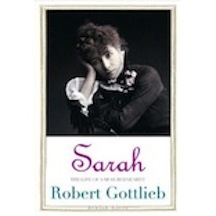 Sarah: The Life of Sarah Bernhardt
Sarah: The Life of Sarah Bernhardt
by Robert Gottlieb
Yale University Press. 256 pages, $25.
MARK TWAIN wrote famously: “There are five kinds of actresses: bad actresses, fair actresses, good actresses, great actresses—and then there is Sarah Bernhardt.” Twain of course was not the only one to comment upon Bernhardt’s uniqueness as an actress. Her death in 1923 ended a sixty-year career in the theatre, where she had become the most recognized woman in France, and had an international reputation that exceeded any stage actress before her. As with many exaggerations about her life, it was estimated that a stack of all the photos ever taken of her would reach the height of the Eiffel Tower, and that all the articles ever written about her, laid end to end, would circle the globe. She was the first international celebrity at the moment when the idea of a celebrity was just taking shape.
The noted New Yorker editor and writer Robert Gottlieb takes a daring plunge into the complexities of Bernhardt’s life. The book is deceptively slim for the grand personality that it covers, but Gottlieb manages to synthesize and dramatize the vast archive of Bernhardt’s life concisely. The biography is less a story from birth to death than an exploration of different stories that have been told about Bernhardt’s life, including by the actress herself. In one sense the book is really a set of questions, as the opening lines make clear: “Sarah Bernhardt was born in July or September or October of 1844. Or was it 1843? Or even 1841?” Gottlieb believes that the truest picture of the actress emerges when we avoid trying to pin down the facts.
By the end of her life, Berhardt was an icon of French culture and national identity. She had come to acting through the Conservatoire in Paris and began her career in the prestigious Comédie-Française. She had performed in thousands of plays, taking on laborious tours in Europe, the U.S., and South America. Such was the unlikely outcome for an illegitimate child of a Jewish mother, raised in a convent, who was herself an unwed mother at the age of twenty. While she converted to Catholicism at a young age, critics often commented on her Jewishness when panning a performance. Gottlieb suggests that Bernhardt’s motivation for acting didn’t stem from a compelling love of the stage but from a desire an escape a “difficult domestic situation” with a mother whose love was restrained and whose excesses were debilitating.
One consistent theme in Bernhardt’s life story is her ability to charm men of privilege and talent. While charming the aristocrats and writers of her day, including Victor Hugo and the Prince of Wales (to name but two), she continues to charm her biographers, including Gottlieb, who focuses here on the actress rather than the person. His admiration for Bernhardt’s performances animate the story he tells as he expertly places us in the front row and describes her acting style, which was both celebrated and reviled by the critics of her day. “Sarah was a child of the Romantic movement,” writes Gottlieb, “and her theater was the theater of feelings, of rebellion, of the Self.” Nevertheless, her acting style transformed the understanding of stage performance, such that the line between the actress and her characters disappeared. This emotional realism contrasted sharply with the standard classicism of the day that valued restraint over emotion, where characters were more important than the actors who played them. Defending Bernhardt’s melodramatic performances, Jules Lemaître, a critic, friend, and lover, wrote that the actress “puts not only her whole heart, soul, and physical grace into her roles but all her sexuality.” Gottlieb concludes that this was at the heart of her appeal: “the glamour, the excitement, the seductiveness of her personality.”
Heterosexual seduction is a crucial component in Gottlieb’s book. Throughout, Bernhardt’s male lovers are credited with compelling manliness. One lover is described as “proud and virile,” another as a “formidably masculine poet.” In describing Lucien Guitry, one of Bernhardt’s leading men in the 1890’s, Gottlieb writes that “he was big, masculine, a ladies man.” But when it comes to homosexual attractions and seductions, Gottlieb is painfully reticent, dedicating only one paragraph to the actress’s “supposed Sapphism.” He glances over the close, lifelong friendship between Bernhardt and painter Louise Abbéma, whom he describes as a “monkeylike little woman who was a prominent member of Paris’s lesbian world.” He questions the extent of such relationships, and strangely and somewhat dismissively concludes that Bernhardt “may have been bisexual, or perhaps she just liked giving pleasure to her friends and had no reservation about how to do it.” I’m not quite sure what “giving pleasure” means here, but I’m intrigued.
Bernhardt was hardly one to confine herself to the norms of sexual or gender codes of her time. Her unconventionality was a significant part of her attraction, and a big part of her legend today. She maintained a long friendship with Oscar Wilde, who wrote Salomé with Bernhardt in mind (a fact that Gottlieb mentions only briefly). She took on such male roles as Shylock and Hamlet, much to the discomfort of critics, with the same skill as she displayed in female roles such as Phèdre. What do we make of her acting the male parts on stage? What do we make of her resistance to gender and sexual norms? Unfortunately, Gottlieb puts such questions on the side.
Today, more than 150 years after Bernhardt started studying acting, you can watch three-minute excerpts on YouTube—something the actress would have enjoyed, I suspect—from silent films in which she plays Queen Elizabeth or Hamlet fencing with Laertes. Gottlieb’s biography offers a compelling story of Bernhardt’s life and art. But, as in these excerpts, there is a pervasive silence in this book about some important issues.






